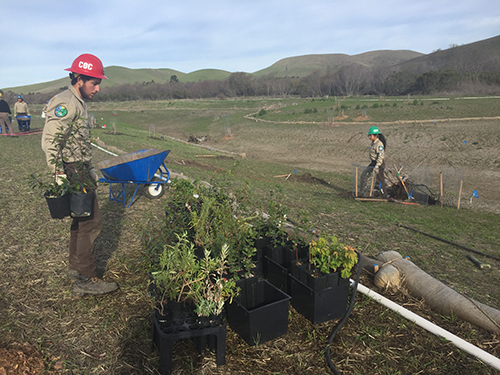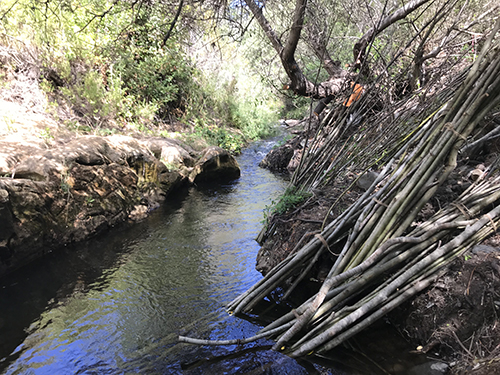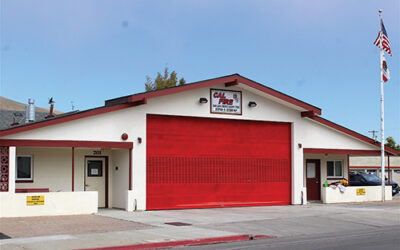Newly planted vegetation grows at the Chorro Creek Ecological Reserve restoration site.
No matter how you look at it 2020 was a turbulent year, but there was some good news on the environmental front that might have been missed between the pandemic, the massive wildfires and political derision. A local project two decades in the making was completed and will remain long after the memories of current times.
Work is complete on a massive floodplain restoration project near the base of Hollister Peak in the Chorro Creek Ecological Reserve designed to improve groundwater supplies, allow native plants to thrive and provide 4.8- acres of critical habitat California red-legged frog, steelhead trout, and other protected wildlife.
Historically, the land that had been farmed. Both banks of the creek were leveed and water had been diverted from the creek for irrigation purposes.
Efforts were done jointly through the Morro Bay National Estuary Program The California Department of Fish and Wildlife (CDFW) and their partners.

Photos courtesy of the Morro Bay National Estuary Program
“We are so proud to see this important project completed and are excited to monitor the site over time to see how conditions improve,” said Estuary Executive Director Lexie Bell. “This project demonstrates the value of partnerships and shared goals – we can accomplish a lot when we all focus on supporting a clean and healthy bay.”
In 2001, the property was slated to be developed into a resort and golf course, but was purchased to protect natural areas and water quality. The land was then transferred to CDFW for ownership and management.

The project repaired a major source of erosion, and relocated 24,000 cubic yards of sediment to construct floodplain habitat, which greatly reduced the amount of excess sediment available to flow into Chorro Creek.
“The excavated sediment was transferred to an upland area adjacent to the floodplain and reseeded with native plants,” said Restoration Projects Manager Carolyn Geraghty. “Concrete riprap that had been used to control flows in the creek’s side channel was taken off site and recycled at a local facility.”

Land uses that degrade vegetation around creeks and destabilize soils contribute significantly to erosion and sedimentation. These processes are causing the bay to fill in at a rate that is faster than would naturally occur, according to Estuary officials. The Estuary Program focuses on two main project types to address sedimentation – trapping sediment before it reaches the bay and improving upstream habitats to prevent erosion
The project also removed part of a levee system, restored and expanded the natural floodplain, and included a partnership with the California Conservation Corps, whose members cultivated and planted more than 1,400 native trees, shrubs, and other plants on the Reserve. A total of 33,600 tons of earth were moved during the project.

The Chorro Creek Ecological Reserve is located about four miles before Chorro Creek enters the Morro Bay estuary.
“This project is a big win for Morro Bay and Los Osos residents,” said Bell “It helps keep harmful sediment out of our bay and brings this part of the creek back to a healthy, natural state so that steelhead and other wildlife can thrive”
Originally, the Trust for Public Lands purchased the property for $2.9 million. Additional costs include, the design phase at $227,000, which was covered primarily by CDFW grant funds. The implementation (construction and planting) phase cost $1.5 million and was covered mostly by CDFW grant funds, with additional grants from State Coastal Conservancy, and U.S. EPA. Restoration projects in areas such as creeks must meet a lot of permitting and species protection requirements, which can make these projects relatively lengthy and high cost, according to Bell.
Why was keeping the land under public ownership important?
“Public ownership means protection forever. It also means any restoration projects are given additional scrutiny to meet a very high standard,” Bell said.
Anyone hoping to hike out and enjoy the work are going to have curb that desire, the property is owned by the CDFW and has a special designation as an Ecological Reserve. Properties under this designation are not open to the public.
As for the future, the Morro Bay National Estuary Program and project partners will continue to care for the 1,400 plantings through watering and weeding of the site over the next few years.
“We will also continue monitoring the flow of water through the creek channels to ensure that project objectives are met,” Geraghty said. “Further management of the upland habitats adjacent to the floodplain will also be important in a future phase of the project.”
Partners involved in the original purchase of the land included Trust for Public Land, Wildlife Conservation Board, U.S. Fish and Wildlife Service (USFWS), the State Coastal Conservancy, Caltrans, the Morro Bay National Estuary Program, the Nature Conservancy, and the City of Morro Bay.



